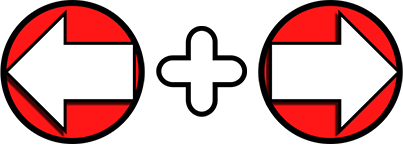
What is SOCD?
SOCD Inputs
SOCD Output
SOCD Resolution
An SOCD Resolution is the what the controller, device, or game decides to be done with an SOCD Input or Output - the community also refers to this as SOCD Cleaning or SOCD Handling.
There are many ways an SOCD can be resolved. By using both directions, choosing only one, or neither.

Now that you have SOCDs on the brain, let us go over the most well-known SOCD Resolutions in controllers, as well as some game-side Resolutions developers have come up with.
Controller-Side Resolutions
There are many types of SOCD Resolutions found in controllers and devices. Below are the more popular and well known Controller-Side Resolutions.
Natural Resolution (or No Resolution)
Both directions are used. Neither are prioritized or neutralized.
Neutral
Absolute Priority
One of the directions is always chosen over the other.
For example, Up always being prioritized when both Up and Down are pressed at the same time.
Hit Box Resolution
Last Input Priority
Second Input Priority (or Last Input Controlled Priority)
Less Familiar Resolutions
-
First Input Priority
- The first direction pressed or activated takes priority over any later opposite directions until that first is deactivated.
- The first direction pressed or activated takes priority over any later opposite directions until that first is deactivated.
-
First-input Controlled Priority
- Once the SOCD is initiated, the second input is deactivated and stays that way until two conditions are met: the first input is un-actuated and the second input is re-actuated.
Game-Side Resolutions
- Vanilla MvC3 does not resolve Left + Right SOCD, and will give you both inputs. This leads to weird things like blocking on both sides at the same time.
- Plenty of games released on console and PC prior to 2016 have Natural Resolution. This is why rulesets were created for Controller-Side SOCD Resolutions, to ensure fair competitive play across all games.
- Street Fighter 6
- Tekken 8
- Street Fighter V prioritizes Up over Down.
- In Street Fighter V, the game prioritizes the "forward" direction. So, on player 1 side, Left + Right = Right, and on player 2 side Left + Right = Left.
Summary
- SOCD stands for "Simultaneous Opposing Cardinal Directions."
- Resolutions are what a controller or game output when an SOCD is actuated.
- There are many ways to resolve SOCDs, but the most popular one in controllers and rulesets is Neutral.
- Game developers have their own ways of dealing with SOCDs, with a standard yet to be established.
